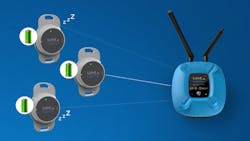11 Myths About Cellular IoT Design
This article appeared in Electronic Design and has been published here with permission.
Internet of Things (IoT) implementations typically utilize low-power wireless technologies like Bluetooth, Wi-Fi, and LoRa for connectivity, enabling wireless devices like sensors to remain in the field for extended periods of time on a single battery charge. The low operational costs of those wireless technologies have also made them ideal for IoT, where the sheer number of devices involved in deployments make data-transfer costs important to manage.
Cellular technology has largely been the domain of smartphones and tablets, with limited usage in IoT implementations because of their battery usage and the higher operational costs of data transfer via cellular networks. That dynamic has changed with the availability of two ultra-low-power versions of cellular technology designed specifically for IoT: LTE-M and NB-IoT (Fig. 1).
In this article, we’ll dispel 11 myths about cellular IoT and explain how the new protocols make cellular technology an attractive option for engineers designing IoT devices and network deployments.
1. The ubiquity of cellular infrastructure would be great as a foundation for connecting IoT devices, but cellular technology would drain a sensor’s battery in the blink of an eye.
That was true in the past, but no longer now thanks to the two new versions of the LTE cellular protocol, which were designed specifically for IoT deployments. Yes, the concern about battery drain is very valid when you look at the version of cellular technology that’s used in iPhones, Galaxy mobile phones, tablets, and other consumer devices. Those devices require an “always-on” approach that aligns with how they’re used, with functions and apps that regularly check the network for messages, calls, and other functions.
The cellular standard for consumer devices is also designed to handle high-throughput applications like video streaming. It’s a constant drain on batteries, which is why our kids are always hyper-aware of the battery level on their devices and looking for a place to plug in. Such a protocol would drain an IoT device’s battery in a hurry, but temperature sensors don’t need to watch YouTube videos.
The new LTE-M and NB-IoT protocols use sleep cycles and other clever hardware and software engineering approaches to sip energy rather than guzzle it. Note that LTE-M/NB-IoT hardware can be scaled down by this bandwidth limitation, allowing the device to be less processor-intensive and therefore less of a power drain. These qualities combine to allow a device’s battery to last for 10 years or more in the field.
2. Cellular technology isn’t built for low-bandwidth devices with infrequent data transfers.
That may be true with the version of cellular for your iPhone or Galaxy, but it’s not true for LTE-M and NB-IoT. These two new cellular protocols designed for low-bandwidth IoT applications use wireless devices that only need to transfer data infrequently. After those occasional data transfers, the sensor or other device can quickly go back to sleep, minimizing the drain on the battery (Fig. 2).
3. But my deployments are really big. There’s no way cellular IoT could be cost-effective.
LTE-M and NB-IoT were designed to have operational costs at scale that make them competitive with other protocols used for IoT deployments. The operational costs and total cost of ownership of cellular IoT will be eye-opening to engineering teams.
It’s also important to keep in mind that LTE-M and NB-IoT remove the network infrastructure from the customer’s and OEM’s cost structure. By using public cellular network infrastructure, the organization doesn’t need to deploy the network, own it, and maintain it. Those costs are borne by the wireless carrier, which eliminates a source of operational costs for IoT deployments.
4. Designing with cellular technology is complex and frustrating.
Cellular design with the protocol intended for smartphones and tablets is indeed complex. That’s a discipline unto itself in the wireless engineering industry, but the two IoT-specific versions of the cellular protocol are far simpler to work with than traditional cellular. It was a guiding principle of the working group that created LTE-M and NB-IoT, specifically because of the perception that cellular technology was difficult to work with.
Yes, these cellular IoT protocols are still more complex to certify than Bluetooth, for example. However, embedded solutions can sidestep that complexity, reducing the risks that are part of testing and certification for wireless projects.
5. The carriers don’t care about IoT. They make their money elsewhere and IoT isn’t a priority.
There’s a misconception that carriers would be hostile or, at best, indifferent to any use of their networks not related to their primary services to consumers and business clients. The opposite is true: Carriers see the growth of IoT as a way to make their networks more vital and to be more robustly utilized by balancing different kinds of data traffic across the same infrastructure. For that reason, telecom carriers played a pivotal role in making LTE-M and NB-IoT possible.
The working group that created the two protocols wanted to ensure IoT deployments using cellular infrastructure as a foundation would be well-supported by carriers. These protocols represent a win-win for the carriers and organizations doing cellular IoT deployments.
6. Approving the technology is one thing, but carriers will never care about IoT enough for me to have important IoT deployments rely on them.
The reality is that carriers are competing hard for IoT customers. They wouldn’t be devoting resources to this if they didn’t see it as vital to the value of their networks, as discussed in Myth #5. By making their networks a backbone for IoT, carriers are aligning themselves with one of the fastest-growing areas of the wireless industry.
Carriers aren’t hostile or indifferent to IoT. They see it as a key to their future because there’s an upper limit on how many cellular subscriptions can be derived from consumer devices like smartphones and tablets. By making their networks a viable backbone for IoT implementations, carriers can drive growth by supporting billions of additional devices.
7. Ten years of battery life is pure marketing fluff. There’s no way that’s possible in the real world.
I’m as skeptical as they come when it comes to spec sheets about wireless technology, but this isn’t a marketing claim. It’s math. Yes, the exact math depends on the size of your battery and other aspects of your design, but the battery life of LTE-M and NB-IoT devices is remarkable.
LTE-M and NB-IoT are designed with sleep/wake cycles that enable engineers to have devices successfully serve their purpose while sipping energy in remarkably small amounts. The key capabilities involved are called Power Saving Mode (PSM) and Extended Discontinuous Reception (eDRX), which work in concert with each other to extend battery life.
PSM allows devices to be programmed to go into a deep-sleep mode while still being reachable. eDRX optimizes the length of time between paging cycles, which can be extended in 10.24-second increments for long periods of inactivity in between activating a paging window. Together, these two technologies make 10-year battery life a potential reality (again, depending on your device design and battery size) in real-world settings rather than just a marketing claim.
8. I can’t use cellular IoT because I don’t know which protocol I will end up using for each IoT device that’s provisioned.
Engineering teams don’t face an either/or decision when it comes to LTE-M and NB-IoT. Unlike some other wireless protocols that force you to make hard choices early in the design process, cellular IoT allows you to embed both technologies in a device. Therefore, your team has the option of using one or the other as best suits the implementation, as well as the flexibility on how that device will be used later on. The provisioner will be able to optimize the device’s and IoT network’s performance later by leveraging whichever makes the most sense on a device-by-device basis.
9. Cellular certification is arduous, and I can’t afford to have it lengthen my time to market for this IoT project.
Yes, certification of cellular has more layers when compared to a technology like Bluetooth, but that process can be de-risked and accelerated by using pre-certified modems based on LTE-M and NB-IoT. The layers of certification for cellular include radio regulatory (FCC/IC, and so on), network (PTCRB/GCF), and carrier (AT&T certifications). Working with pre-certified wireless components and an experienced wireless-design partner can help navigate those steps to minimize setbacks and speed time to market.
10. I also want to use other wireless technologies, but cellular has never played nicely in the sandbox.
I believe a large percentage of cellular IoT deployments will involve implementations of multiple wireless technologies, which makes it critical for cellular IoT to work well alongside other wireless protocols (Fig. 3). Bluetooth is a particularly attractive complement to LTE-M and NB-IoT, with Bluetooth doing the short distance device-to-device communication and LTE-M/NB-IoT doing the backhaul communication to the network.
Companies combining cellular IoT with other protocols like Bluetooth need to carefully navigate how to co-locate multiple radios to optimize performance and successfully pass certifications. Pre-certified solutions that take care of the cellular-and-Bluetooth integration make the process even simpler and faster for engineers.
11. Cellular IoT is interesting, but it’s not relevant for very many real-world projects.
Now that engineering teams are realizing that cellular technology is practical and cost-effective for IoT projects, the number of use cases they’re looking at spans across a long list of industries and business needs. This white paper does a deep dive into three cases that utilize cellular IoT and Bluetooth technologies for actual applications involving cold-chain monitoring, industrial equipment monitoring (Fig. 4), and electric charging stations. These three cases just scratch the surface of how cellular IoT will be used.
Jonathan Kaye is Senior Director of Product Management at Laird Connectivity.
About the Author
Jonathan Kaye
Senior Director of Product Management, Laird Connectivity
Jonathan Kaye is the senior director of product management at Laird Connectivity, which provides a full range of antenna solutions and wireless modules that simplify the process of using wireless technology. Kaye is a lead developer of Laird’s embedded wireless connectivity solutions. He has more than 20 years of experience in the embedded wireless and product design field, including positions at EZURiO and Lever Technology before joining Laird a decade ago.




